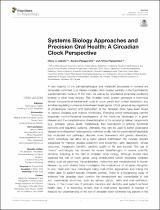| dc.description.abstract | A vast majority of the pathophysiological and metabolic processes in humans are temporally controlled by a master circadian clock located centrally in the hypothalamic suprachiasmatic nucleus of the brain, as well as by specialized peripheral oscillators located in other body tissues. This circadian clock system generates a rhythmical diurnal transcriptional-translational cycle in clock genes and protein expression and activities regulating numerous downstream target genes. Clock genes as key regulators of physiological function and dysfunction of the circadian clock have been linked to various diseases and multiple morbidities. Emerging omics technologies permits largescale multi-dimensional investigations of the molecular landscape of a given disease and the comprehensive characterization of its underlying cellular components (e.g., proteins, genes, lipids, metabolites), their mechanism of actions, functional networks and regulatory systems. Ultimately, they can be used to better understand disease and interpatient heterogeneity, individual profile, identify personalized targetable key molecules and pathways, discover novel biomarkers and genetic alterations, which collectively can allow for a better patient stratification into clinically relevant subgroups to improve disease prediction and prevention, early diagnostic, clinical outcomes, therapeutic benefits, patient's quality of life and survival. The use of “omics” technologies has allowed for recent breakthroughs in several scientific domains, including in the field of circadian clock biology. | en_US |

